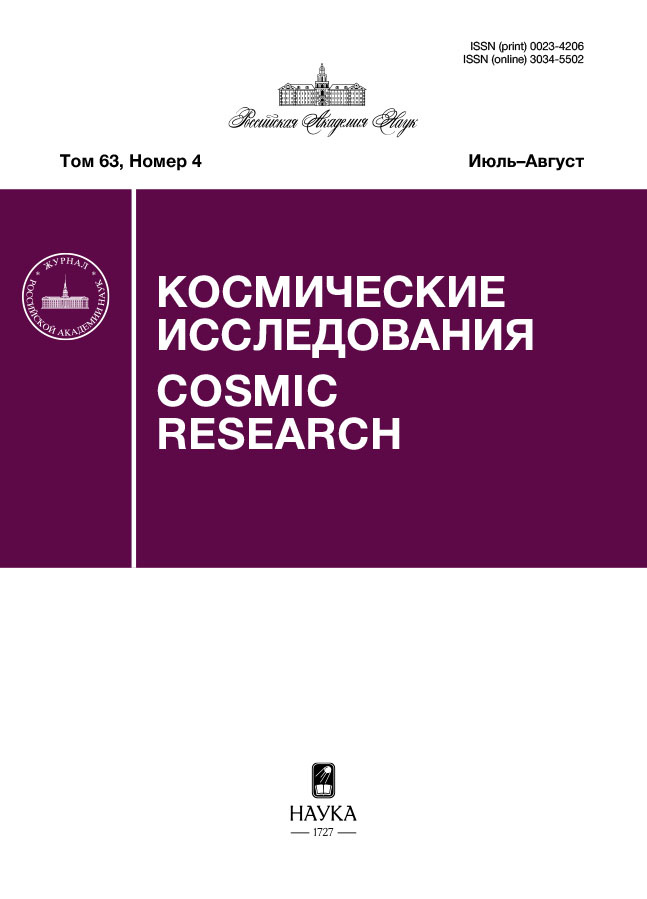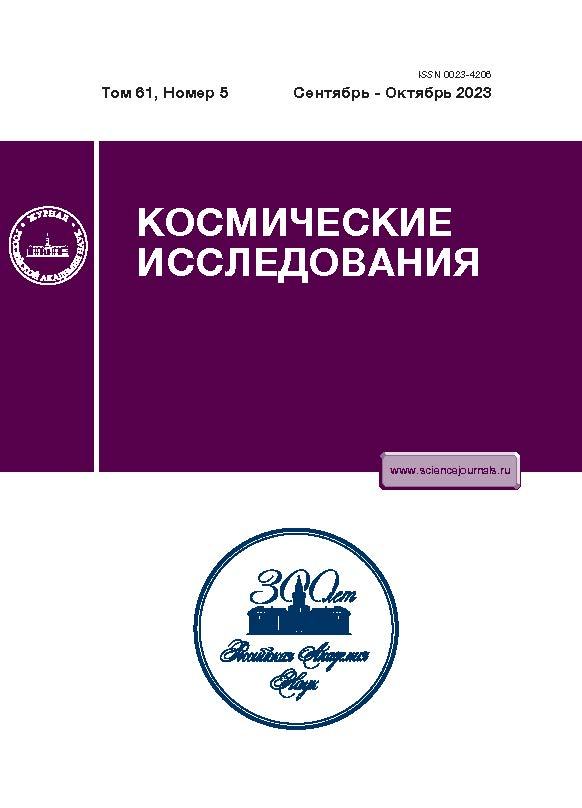Оптимизация гелиоцентрических траекторий с малой тягой между коллинеарными точками либрации различных планет
- Авторы: Петухов В.Г.1, Юн С.У.2
-
Учреждения:
- Научно-исследовательский институт прикладной механики и электродинамики Московского авиационного института
- Московский авиационный институт
- Выпуск: Том 61, № 5 (2023)
- Страницы: 406-419
- Раздел: Статьи
- URL: https://kld-journal.fedlab.ru/0023-4206/article/view/672618
- DOI: https://doi.org/10.31857/S0023420623700127
- EDN: https://elibrary.ru/PJLNXO
- ID: 672618
Цитировать
Полный текст
Аннотация
Цель исследования заключается в оптимизации межпланетного перелета космического аппарата с малой тягой с использованием коллинеарных точек либрации L1 и L2 для стыковки геоцентрического или планетоцентрического участков траектории с гелиоцентрическом участком. Рассматривается задача оптимизации возмущенного гелиоцентрического участка траектории межпланетного перелета с малой тягой в рамках эфемеридной модели четырех тел, включающей Солнце, Землю, планету назначения и космический аппарат. Для оптимизации траекторий используется непрямой подход, основанный на использовании принципа максимума Понтрягина и метода продолжения. Показывается возможность сокращения требуемых затрат характеристической скорости по сравнению с оценками, полученными с применением метода точечных сфер действия.
Об авторах
В. Г. Петухов
Научно-исследовательский институт прикладной механики и электродинамикиМосковского авиационного института
Email: PetukhovVG@mai.ru
Россия, Москва
С. У. Юн
Московский авиационный институт
Автор, ответственный за переписку.
Email: YunSU@mai.ru
Россия, Москва
Список литературы
- Topputo F., Belbruno E. Earth–Mars transfers with ballistic capture // Celestial Mechanics and Dynamical Astronomy. 2015. V. 121. Iss. 4. P. 329–346. https://doi.org/10.1007/s10569-015-9605-8
- Mingotti G., Topputo F., Bernelli-Zazzera F. Earth – Mars transfers with ballistic escape and low-thrust capture // Celestial Mechanics and Dynamical Astronomy. 2011. V. 110. Iss. 2. P. 169–188. https://doi.org/10.1007/s10569-011-9343-5
- Mingotti G., Gurfil P. Mixed low-thrust invariant-manifold transfers to distant prograde orbits around Mars // J. Guidance, Control, and Dynamics. 2010. V. 33. Iss. 6. P. 1753–1764. https://doi.org/10.2514/1.49810
- Topputo F., Vasile M., Bernelli-Zazzera F. Low Energy Interplanetary Transfers Exploiting Invariant Manifolds of the Restricted Three-Body Problem // The J. Astronautical Sciences. 2005. V. 53. Iss. 4. P. 353–372. https://doi.org/10.1007/BF03546358
- Ovchinnikov M. Interplanetary Small-Satellite Missions: Ballistic Problems and Their Solutions // Gyroscopy and Navigation. 2021. V. 12. Iss. 4. P. 281–293. https://doi.org/10.1134/S2075108721040064
- Lo M., Ross S. The Lunar L1 Gateway: Portal to the Stars and Beyond // AIAA Space 2001 Conference. 28–30 Aug. 2001, Albuquerque, New Mexico. https://doi.org/10.2514/6.2001-4768
- Ross S., Koon W., M.W. Lo et al. Design of a Multi-Moon Orbiter // 13th AAS/AIAA Space Flight Mechanics Meeting. 9–13 Feb. 2003, Ponce, Puerto Rico. Art. ID. AAS 03-143. P. 669.
- Loeb H., Petukhov V., Popov G.A. et al. A Realistic concept of a manned Mars mission with nuclear-electric propulsion // Acta Astronautica. 2015. V. 116. P. 299–306. https://doi.org/10.1016/j.actaastro.2015.07.019
- Petukhov V., Yoon S.W. End-to-End Optimization of Power-Limited Earth – Moon Trajectories // Aerospace. 2023. V. 10. Iss. 3. Art. ID. 231. 21 p. https://doi.org/10.3390/aerospace10030231
- Petukhov V.G. One numerical method to calculate optimal power-limited trajectories // Intern. Electric Propulsion Conf. IEPC-95-221. Moscow, 1995. P. 1474–1480.
- Petukhov V.G. Optimization of Interplanetary Trajectories for Spacecraft with Ideally Regulated Engines Using the Continuation Method // Cosmic Research. 2008. V. 46. Iss. 3. P. 219–232. https://doi.org/10.1134/S0010952508030052
- Petukhov V.G. Method of continuation for optimization of interplanetary low-thrust trajectories // Cosmic Research. 2012. V. 50. Iss. 3. P. 249–261. https://doi.org/10.1134/S0010952512030069
- Haberkorn T., Martinon P., Gergaud J. Low thrust minimum-fuel orbital transfer: a homotopic approach // J. Guidance, Control, and Dynamics. 2004. V. 27. Iss. 6. P. 1046–1060. https://doi.org/10.2514/1.4022
- Jiang F., Baoyin H., Li J. Practical techniques for low-thrust trajectory optimization with homotopic approach // J.Guidance, Control, and Dynamics. 2012. V. 35. Iss. 1. P. 245–258. https://doi.org/10.2514/1.52476
- Petukhov V., Ivanyukhin A., Popov G. et al. Optimization of finite-thrust trajectories with fixed angular distance // Acta Astronautica. 2022. V. 197. P. 354–367. https://doi.org/10.1016/j.actaastro.2021.03.012
- Petukhov V.G., Yoon S.W. Optimization of perturbed spacecraft trajectories using complex dual numbers. Part. 1: Theory and method // Cosmic Research. 2021. V. 59. Iss. 5. P. 401–413. https://doi.org/10.1134/S0010952521050099
- Dargent T. Automatic Minimum Principle Formulation for Low Thrust Optimal Control in Orbit Transfers using Complex Numbers // Proc. 21st Intern. Symp. Space flights Dynamics. 28 Sep.–2 Oct. 2009, Toulouse, France. 2009. 9 p.
- Dargent T. An integrated tool for low thrust optimal control orbit transfers in interplanetary trajectories // Proc. 18th Intern. Symp. Space Flight Dynamics. 11–15 Oct. 2004, Munich, Germany. 2004. ESA SP-548. P. 143.
- Bertrand R., Epenoy R. CNES Technical note n°147. December 2002. P. 36.
Дополнительные файлы


























